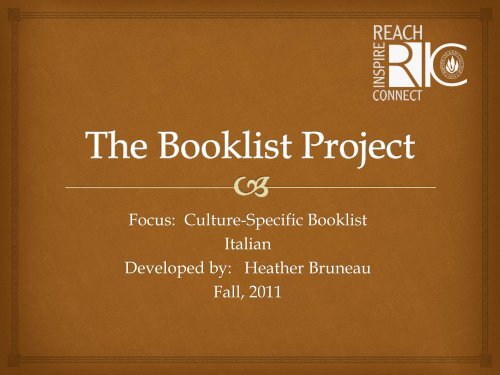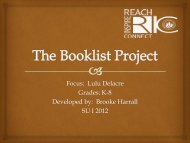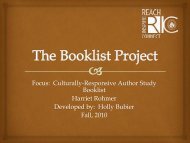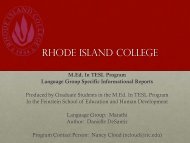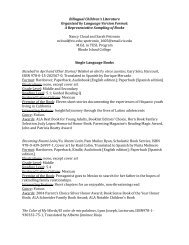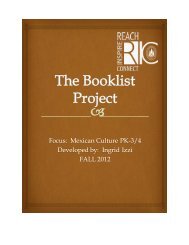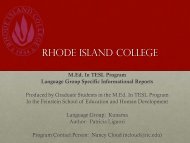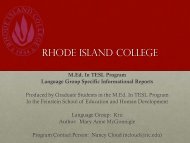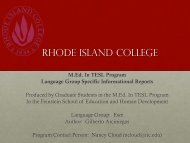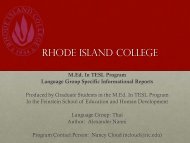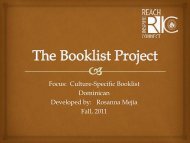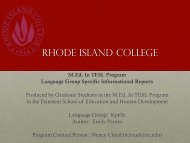Italian Booklist by Heather Bruneau for Grades K-3.pdf - RITELL
Italian Booklist by Heather Bruneau for Grades K-3.pdf - RITELL
Italian Booklist by Heather Bruneau for Grades K-3.pdf - RITELL
- No tags were found...
You also want an ePaper? Increase the reach of your titles
YUMPU automatically turns print PDFs into web optimized ePapers that Google loves.
Focus: Culture-Specific <strong>Booklist</strong><strong>Italian</strong>Developed <strong>by</strong>: <strong>Heather</strong> <strong>Bruneau</strong>Fall, 2011
BOOK LIST PROJECTITALY GRADES K-3H EATHER BRUNEAU
Fleming, C. (2001) Gabriella’s song. New York: AladdinPaperbacks.[ISBN: 0-689-84175-2]DRA level: 28Interest level: K-2WIDA level: Developing/ExpandingIn this story, Gabriella walks the streets of Venicehumming the tune she hears in air. The tune soonreaches the ears and lips of the baker, the widow, thegondolier, and finally the famous composer GiuseppeDel Pietro who turns Gabriella’s tune into a symphony.This book portrays the importance of music in Venice, Italy while captivating the reader withpictures that illuminate the essence of life along the Grand Canal. <strong>Italian</strong> exclamations such as“amore mio”, “bellissima”, “bravissimo”, and “grazie” are used throughout the text along withauthentic <strong>Italian</strong> names, bringing the culture and the language of Italy to life. ELLs could relateto the culture presented in this book, which is so unique to Italy.Also available in hardcover [ISBN: 0-689-80973-5]Additional Resourceswww.candaceflemming.comThe author’s website provides a teaching guide <strong>for</strong> Gabriella’s Song. In<strong>for</strong>mation aboutother historical pictures books written <strong>by</strong> the author is also available.2
Cooper, S.K. (2006) Italy ABCs: A book about the people andplaces of Italy. Minneapolis: Picture Window Books.[ISBN: 1-4048-1569-4]DRA level: 28+ (content vocabulary is challenging)Interest level: grades 1-3WIDA level: ExpandingThis book takes readers on an alphabetical journey through Italy. Each page explains aspectsof the history and culture of the country. Students learn about famous people such as JuliusCaesar and Leonardo da Vinci, and plants such as olives and grapes. The geography andarchitecture of Italy are explained through descriptions and illustrations of The Leaning Towerof Pisa, the Coliseum, and Mount Etna. Readers learn about the influence of artists such asMichelangelo, Sandro Botticelli, and Raphael. Each page has up to three sentences to explain atopic in general terms, with a fast fact that offers more detailed in<strong>for</strong>mation. This book wouldbenefit ELLs who have studied the history and culture of Italy <strong>by</strong> providing vocabulary to helpthem communicate their knowledge in English.Additional Resourceswww.einaudi.cornell.edu/europe/outreach/pdf/brosch/Italy.pptThis is a very simple power point that could be used to help an ELL from Italy begin totalk about his/her native country. It could also be used to begin a social studies unitabout Italy.www.kidport.com/RefLib/WorldGeography/Italy/Italy.htmThis website is appropriate <strong>for</strong> children and gives a simple explanation of geographiclandmarks, points of interest, climate, population and culture about Italy and othercountries around the world.www.travel<strong>for</strong>kids.com/Funtodo/Italy/italy.htmThis website uses both pictures and words to describe exciting experiences <strong>for</strong> childrenin each of Italy’s major cities. ELLs can have many experiences that they are not able tocommunicate. This website could help these students describe the places they’ve beenand the things they’ve done.http://www.pocanticohills.org/italy/italy.htm3
This website is designed <strong>for</strong> children. It gives very basic in<strong>for</strong>mation about manyelements of <strong>Italian</strong> culture. There are also games, puzzles, and quizzes <strong>for</strong> children tocomplete based on the in<strong>for</strong>mation presented on the website.http://library.thinkquest.org/CR0212302/italy.htmlThis website was designed <strong>by</strong> fourth and fifth graders <strong>for</strong> the ThinkQuestUSA website.It promotes acceptance of other cultures. The tab called “A kid’s life in…” providesreaders with in<strong>for</strong>mation about what it is like to be a child living in a different country.Students can learn what it’s like to live in Italy, as well as many other countries includingSaudi Arabia, Afghanistan, Pakistan, and more.http://www.time<strong>for</strong>kids.com/destination/italyThis section of Time For Kids helps children connect to <strong>Italian</strong> culture <strong>by</strong> learning basic<strong>Italian</strong> words, learning about the geography, and reading about the daily life of a girlliving in Italy.4
Falconer, I. (2010) Olivia goes to Venice. New York: Atheneum Books<strong>for</strong> Young Readers.[ISBN: 978-I-4I69-9674-3]DRA level: 24Interest level: PreK-2WIDA level: DevelopingThe famous Olivia makes her mark on Venice. While there, shevisits the Piazza San Marco and rides a gondola down the GrandCanal, which brings her under the Rialto Bridge and the Bridge ofSighs. As a true tourist, Olivia makes her way through the city eating one gelato after another.Young readers will find this book amusing while ELLs will make connections to the places Oliviavisits and her experiences in Italy.Also available in eBook <strong>for</strong>mat [ISBN-13: 978-1-4424-2737-2]Additional Resourceshttp://www.oliviathepiglet.com/Olivia’s own website allows her fans to learn about her other books, play games, learnabout the author of her books and interact with her online.5
Grodin, E.D. & Cuomo, M.M. (2009) C is <strong>for</strong> ciao: An <strong>Italian</strong> alphabet.Michigan: Sleeping Bear Press.[ISBN: 978-1-58536-361-2]DRA level: 28 (simple text)Interest level: grades 1-4WIDA level: This book is written on two levels.Simple, rhyming text: DevelopingExtended explanations in paragraph <strong>for</strong>m: Bridging +This book is dynamic as it takes readers on an alphabetical exploration of Italy. Each page usesrhyme to tell a simple fact about Italy. In the margins, the reader can find up to eightparagraphs that elaborate on the topic. This book can be read to/<strong>by</strong> young readers who willenjoy the sing-song element of the journey through Italy. Older readers can gain a deeperunderstanding of the history of Italy through reading the margins. ELLs can make connectionsthroughout the text.Additional Resourceshttp://www.gale.cengage.com/pdf/TeachersGuides/ItalyTeachersGuide.pdfThis website is a link off of the publisher’s site. It includes a 25-page teaching guide touse with the book.6
Mauner, C. & Smalley, E. (2003) Zoe Sophia’s scrapbook: Anadventure in Venice. San Francisco: Chronicle Books.[ISBN: 0-8118-3606-1]DRA level: 30 -34Interest level: <strong>Grades</strong> 1 - 3WIDA level: ExpandingZoe Sophia packs her bags and her dog Mickey and heads toVenice, Italy to stay with her Aunt Dorothy <strong>for</strong> a week. Whilethere, she eats cornetti and spremuta <strong>for</strong> la prima collazione(breakfast). She tries on Carnevale masks at the LaboratorioArtigiano Maschere and takes a gondola ride down the Grand Canal. She shops in the Rialto andgoes to the opera La Traviata at La Fenice. Zoe Sophia visits many of the popular attractions inItaly and infuses <strong>Italian</strong> words onto the pages of the scrapbook she makes of her vacation.ELLs would find Zoe’s travels exciting as she visits places that many <strong>Italian</strong> children would haveexperienced. This book helps native English speaking children understand more about culture ofItaly and the important landmarks. Through this book, native students can ask ELLs about theirexperiences in Italy and the places mentioned throughout the story.Additional Resourceshttp://www.zoesophia.com/Zoe Sophia has her own website where readers can learn about and purchase her otherbooks and adventures, buy her products, and learn more about the authors, ClaudiaMauner and Elisa Smalley.www.tumblebooks.com/library/asp/lessons/ZoeSophiaNewYork.docThis lesson using the comprehension strategy of questioning be<strong>for</strong>e, during, and afterreading the book Zoe Sophia in New York: The Mystery of the Pink Phoenix Papers.www.tumblebooks.com/library/asp/lessons/ZSScrapbook.docThis lesson uses Zoe Sophia’s Scrapbook: An Adventure in Venice to teach children howto document a significant event in their lives through pictures and words.7
Osborne, M. P. (2005) Carnival at Candlelight. New York: Random House<strong>for</strong> Young Readers.[ISBN: 0-3758-3033-2]DRA level: 24-28Interest level: grades 1-3WIDA level: Developing/ExpandingJack and Annie are asked to go back in time to Venice, Italy in order tosave the Grand Lady of the Lagoon from a terrible disaster. Once there,they realize that their visit is on the day of Carnival (Carnevale) and that the entire city is atrisk of being destroyed in a flood. Jack and Annie try to save the city, but instead end up injail. ELLs would benefit from hearing an American perspective about the age old tradition ofCarnival in Italy. This book could also help ELLs explain and discuss their experiences ofCarnival in terms that English speaking peers could understand.Also available in:JapaneseOsborne, M. P. (2007) Benechia tokin no raion. Tokyo: Media Factory.[ISBN:978-48401-1797-5]ChineseOsborne, M. P., Wu, J. & Wang, Y. (2008) Feng kuang jia nian hua. Taibei Shi : Tian xia yuan jiachu ban gu fen you xian gong si. [ISBN: 978-98621-6120-3]<strong>Italian</strong>Osborne, M. P., Murdocca, S., & Ponti, B. (2006) Festa in maschera a Venezia. CasaleMonferrato: Piemme Junior. [ISBN: 978-88384-5233-8]eBookOsborne, M.P. (2009) Carnival at Candlelight. New York: Random House.[ISBN: 978-03758-9455-8]Book on CDOsborne, M.P. (2008) Carnival at Candlelight. Princeton, NJ: Recording <strong>for</strong> the Blind & Dyslexic.[OCLC Number: 271487793]Book on tape8
Osborne, M.P. (2006) Carnival at Candlelight. New York: Random House/Listening Library.[OCLC Number: 70133419]Additional Resourceshttp://teacher.scholastic.com/lessonplans/bookfairs/currconnection/mth_carnival.htmScholastic offers a brief summary of the book with questions to use with a whole class orreading group that scaffold the content so that students can understand what it is like inVenice, Italy.www.magictreehouse.comThe Magic Tree House website allows children to answer questions about each of thebooks in this series in order to earn a “passport” from the place they just read about.There are many other activities and options <strong>for</strong> students who enjoy reading this series.www.marypopeosborne.comThis is the author’s website where she keeps readers updated on her latest books, sharesstories about her inspirations, and offers in<strong>for</strong>mation about Magic Tree House TheMusical. Fans of Mary Pope Osborne can visit her site frequently to catch up on herlatest events.https://fc.mcla.edu/~mn0379@mcla.edu/FOV1-0001CC89/FOV1-0001CC8E/S00789BB4?Plugin=LoftThis lesson plan explains how to make a jeopardy game to use after reading Carnival atCandlelight.9
Osborne, M. P. (1998) Vacation under the volcano. NewYork: Random House Books <strong>for</strong> YoungReaders.[ISBN-13: 978-06798-9050-8]DRA level: 24-28Interest level: grades 1-3WIDA level: Developing/ExpandingThis book is #13 in the Magic Tree House series. In this adventure,Jack and Annie travel to the ancient Roman seaside town of Pompeiiin search of a missing scroll. Jack and Annie meet an old soothsayerwho warns them of danger and a gladiator who scares the wits out of them. To their surprise,Pompeii is at the base of Mount Vesuvius, a volcano that suddenly erupts as they’re searching<strong>for</strong> the scroll in an ancient library. Jack and Annie race against time to get out of Pompeii andback home without losing the scroll that they came <strong>for</strong>. ELLs would enjoy this fictionaladventure through the time of the ancient Roman Empire and to hear the story of what it mayhave been like to live in Italy when the city of Pompeii became frozen in time.Also available in:SpanishOsborne, M. P. & Brovelli, M. (2007) Vacaciones al pie de un volcan. New York: LectorumPublishing. [ISBN: 978-19330-3219-1]<strong>Italian</strong>Osborne, M. P. & Invernizzi, M. (2001) Una vacanza vulcanica a Pompei. Casale Monferrato:Piemme Junior.FrenchOsborne, M. P. & Masson, P. (2003) Panique a Pompei. Paris: Bayard Jeunesse.[ISBN: 2747009777 9782747009775 2747018415 9782747018418]Book on TapeOsborne, M. P. & Greene, G. Vacation on the volcano. (2003) Washington, D.C. : National LibraryService <strong>for</strong> the Blind and Physically Handicapped. [OCLC Number: 58390220]Book on CDOsborne, M. P. (2004) Vacation on the volcano. Princeton, NJ: Recording <strong>for</strong> the Blind &Dyslexic. [OCLC Number: 55764114]10
Additional Resourceshttp://www.mce.k12tn.net/reading11/vacation_under_the_volcano.htmVocabulary, comprehension questions, and extension activities are provided on thiswebsite <strong>for</strong> each chapter of the book.http://images.pcmac.org/Uploads/Exploreum/Exploreum/Divisions/PagesLevel2/Documents/Pompeii%20Teachers%20Guide.pdfThis website is an extensive lesson called “A Day in Pompeii” which brings experiencesinto the classroom to help students gain an understanding of life in the Ancient RomanEmpire. This lesson could be modified to meet the needs of various grade levels.11
Yaccarino, D. (2011) All the way to America: The story of a big<strong>Italian</strong> family and a little shovel. New York: Random HouseChildren’s Books.[ISBN: 978-0-375-86642-5]DRA level: 24Interest level: grades K - 2WIDA level: Beginning/DevelopingThis author tells the story of how his great-grandfather leaves Sorrento, Italy as a young manto look <strong>for</strong> new opportunities in America. His parents send him off with a silver shovel and areminder to work hard, enjoy life, and remember his family. The shovel is passed down fromone generation to the next as each new family establishes themselves as <strong>Italian</strong> Americans.Many ELLs will connect to the theme of immigration to the United States. This book alsorein<strong>for</strong>ces the importance of honoring family values. The author inspires all children to learnabout their ancestors and discover the importance of family heirlooms.Additional Resourceshttp://www2.scholastic.com/browse/lessonplan.jsp?id=517Scholastic provides a detailed lesson plan with numerous extension activities appropriate<strong>for</strong> early elementary age students.http://coreknowledge.org/mimik/mimik_uploads/lesson_plans/742/Immigration%20%20Coming%20to%20America.pdfThis mini social studies unit helps children understand the contributions immigrants havemade in America and develop empathy <strong>for</strong> immigrant experiences traveling to a newcountry.12
Galli, L. (1996) Mona Lisa: The secret of the smile. New York:Delacorte Press.[ISBN-10: 0-3853-2108-2]DRA level: 24 - 28Interest level: <strong>Grades</strong> 1-3WIDA level: Developing/ExpandingThis book follows Leonardo da Vinci from childhood to adulthood as hestudies birds to discover the secret of flight, designs costumes andfestivals <strong>for</strong> the Duke of Milan, and finally paints the most famous portrait in the world, TheMona Lisa. This book helps to explain the Renaissance period <strong>by</strong> glorifying da Vinci’suntraditional methods and abstract thinking. For ELLs, this book helps to bring <strong>Italian</strong> historyinto English. ELLs from Italy may be surprised to realize how much Americans respect thecontributions Italy has made in history, art, education, and more.Additional Resourceshttp://www.diaryof1.com/2008/02/17/leonardo-da-vinci-<strong>for</strong>-kids-2/This website is designed <strong>for</strong> older children and offers more in<strong>for</strong>mation about da Vinci’sinterests. There are also art ideas <strong>for</strong> children to try out, based on the contributions Leonardoda Vinci made to the modern world. Students can find ideas about making maps, drawing horses,and painting birds.13
dePaola, T. (1989) Tony’s bread. New York: G.P. Putnam’s Sons.[ISBN: 0-399-21693-6]DRA level: 38Interest level: grades K-2WIDA level: Developing/ExpandingThis <strong>Italian</strong> folktale tells the story of how panettone, an<strong>Italian</strong> bread, was created. This bread is very popular in thecity of Milano and is enjoyed <strong>by</strong> <strong>Italian</strong>s and Americans alikeduring Christmas. In Tomie dePaola’s version, Tony the bakeris invited to Milano <strong>by</strong> Angelo, a nobleman who wants to marryhis daughter and help Tony open up a new bakery. Aftervisiting Milano, Tony realizes that his bread is too plain <strong>for</strong> the elegant city and sets to workmaking a new recipe with the finest ingredients. Tony’s new bread, panettone, is a hit in Milano.ELLs will most likely know some version of this popular folktale.Additional Resourceshttp://www.brighthub.com/education/early-childhood/articles/70491.aspxThis is a bread lesson targeted <strong>for</strong> younger learners.http://www.lindaslearninglinks.com/food.htmlThis website is a thematic unit about food which includes pizza, bread, pasta, soups, andmore. The lessons incorporate culture and music into the study of each of the differentfoods. There are literature links to each of the different lesson ideas.http://www.tomie.com/Tomie dePaola is an American author from Italy who has written numerous books thatdepict his <strong>Italian</strong> heritage. In<strong>for</strong>mation about the author and his other works can befound on his website.http://ethemes.missouri.edu/themes/1762This website provides links <strong>for</strong> teachers who are using Tomie dePaola’s books in an authorstudy.http://www.childrenslit.com/childrenslit/mai_depaola_tomie.htmlThis website highlights many of dePaola’s works as an author and illustrator. Included isa summary of each book, the ISBN number, price of the book, and target age of audience.14
Non-Print Resourceswww.mamalisa.comThis website has lyrics and music to kid’s songs,nursery rhymes, chants, and finger plays fromcountries around the world. The website is available inEnglish, Spanish, and French. The homepage is divided<strong>by</strong> continent. From there, the user can select thecountry from which he/she would like to find music.For each song, there is an English translation. For manysongs there are directions <strong>for</strong> how to play a game whilesinging the song. You can also find recipes from eachof the countries and literature links to books about theculture. This website is a tool that any ESL teacher can use to find songs in a students’ nativelanguage. ELLs can use this website to help teach English speaking peers songs from his/hernative country.YouTube.com has numerous children’s songs in <strong>Italian</strong>. The following songs can easily be foundand enjoyed <strong>by</strong> children who speak <strong>Italian</strong> or families who are learning <strong>Italian</strong>. Each video alsoprovides a link or website where the viewer can go to download or purchase the song on cd orthrough itunes.Stella StellinaVolevo Un Gatto NeroIl Ballo del Qua QuaIl Pulcino BallerinoIl Gatto PuzzoloneMi Scappo la Pipi15
The <strong>Booklist</strong> ProjectA Project of theM.Ed. In TESL Program,Feinstein School of Education and Human DevelopmentRhode Island CollegeFor Further In<strong>for</strong>mation, Contact:Nancy Cloud, Ed.D., Directorncloud@ric.eduRhode Island College600 Mt. Pleasant AvenueProvidence, RI 02908


